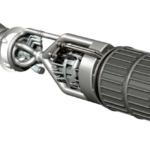FINN Editor-in-chief Alan Peaford looks at why Farnborough is shaking off history with its next-generation show
The quintessential English summer hasn’t changed much since the end of the second World War. There are overpriced strawberries and cream at Wimbledon, hats and horses at Royal Ascot and, every two years, the aerospace industry showcase at Farnborough International Airshow.
In 1948, when the former Society of British Aircraft Companies moved its event from RAF Hendon to the current site in Hampshire, 40 kilometres south west of the capital, the show became a gathering place for thousands of moustachioed men in tweed jackets to reminisce about their times with Herbert Austin and Frederick Handley Page, and admire the latest of British inventions. As time wore on, they also began grumbling about the demise of the UK’s aviation manufacturing business.
However, while Ascot and Wimbledon remain much the same as ever, Farnborough has thrown away the tea-and -Tweed Britishness and instead has shaken up a cosmopolitan cocktail of an event that is as different to its past as 3D printing is to riveting.
Going global
Barely a decade ago, Farnborough Airshow’s very future was in doubt. There was no certainty of tenure at the airport for the show – and, to be honest, not much to shout about for the UK manufacturing industry either.
That has changed, though. As the UK’s aerospace industry has embraced change and technology, and has very firmly established itself as the second-largest aerospace manufacturing nation in the world and a vital link in the global supply chain, so the show organiser, Farnborough International, has adapted to the new world and has made the show even more relevant to the global industry.
I need to declare an interest here – Farnborough International is the owner of FINN, but even that investment into a digital media business is an indication of an organisation thinking outside the box about ways to engage and keep its community informed beyond the biennial cycle of shows.
Having been attending the show for the best part of 30 years, I know how much has changed recently. The security of the venue for years to come has meant the opportunity to invest in the infrastructure. At the same time, the show’s focus has changed toward the ‘international’ element of its name.
Aerospace 4.0
It has also embraced the latest industrial revolution – Aerospace 4.0 – and is applying digitalisation and the best of technology and innovation even to its own processes.
A new app, a new permanent exhibition hall, and product demonstrations “with a difference” are just some of the additions to the 2018 edition of the show, which opens on Monday July 16.
The show’s new app should improve the visitor and exhibitor experience. Amanda Stainer, the show’s commercial director, told the media recently that its geolocation capability, which is being tested at this year’s show, could make all the difference.
“We’ve partnered with a company called Crowd Connected to experiment with targeted location-based messages that we hope will enhance the air show experience,” she said.
“We’re going to encourage everybody to link up on the app,” she added, and it can be downloaded free of charge.
Join the debate
The show site now has a new permanent exhibition and conference facility – Hall 1. With 20,000sqm of flexible space, there is 12,500sqm of exhibition hall and 10 sound-proofed conference and event spaces, allowing meetings and other events to go on even during the Typhoon’s performance outside.
As well as plenty of national pavilions, there are areas for space and, topically, an area dedicated to promoting and explaining Aerospace 4.0.
IN Hall 3 look out for a ‘live product demo area’ where military delegations will merge with actors on a set that will look like an air force command centre and will have clients’ products on display.
There is an Innovation Zone occupied by 17 universities, bringing the latest products created at each facility, which have either been commissioned by industry or which they are looking to sell to industry.
Nearby will be the two theatres under the FINN banner, the Insight Theatre and Innovation Theatre. They will host live, free FINN Sessions conference presentations on key subjects such as Aerospace 4.0, big data, supersonic air transport, Brexit and new technologies. With CEOs, government ministers and industry analysts leading the debate, these sessions will add value for delegates.
There will be a raft of new products being unveiled and plenty to see on the static park, where I expect the battle for the regional markets will be dominating headlines. A growing cargo presence (and a separate conference) reflects the importance of this sector. Defence issues will come to the fore with the UK’s plans for a future combat aircraft strategy likely to be of interest, particularly as Brexit looms.
The strong relationship with European defence companies and the UK manufacturers will be celebrated and, of course, we expect a fair few airline orders too – a higher number of airline CEOs than usual are believed to have signed up this year, and we will be quizzing 10 of them at a roundtable about disruptive influences post-2020.
Farnborough really has moved with the times and the business-to-business activities, coupled with inspiring the next generation at Friday’s Future’s Day, reinforce the show’s relevance. With its digital support and new programmes, it is, more than ever, an event for the whole of the global aerospace community, by the global community.
I look forward to seeing you there,

